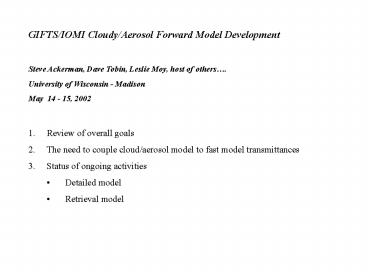GIFTS/IOMI Cloudy/Aerosol Forward Model Development
1 / 14
Title:
GIFTS/IOMI Cloudy/Aerosol Forward Model Development
Description:
The primary objective of this processing algorithm is to detect the presence of ... uses LBLRTM layer optical depths, CPU intensive but needed for error studies. ... –
Number of Views:13
Avg rating:3.0/5.0
Title: GIFTS/IOMI Cloudy/Aerosol Forward Model Development
1
- GIFTS/IOMI Cloudy/Aerosol Forward Model
Development - Steve Ackerman, Dave Tobin, Leslie Moy, host of
others. - University of Wisconsin - Madison
- May 14 - 15, 2002
- Review of overall goals
- The need to couple cloud/aerosol model to fast
model transmittances - Status of ongoing activities
- Detailed model
- Retrieval model
2
GIFTS/IOMI Aerosol Laden Forward Model
Development Relationship to MURI Objectives The
primary objective of this processing algorithm is
to detect the presence of suspended matter such
as dust, sand, volcanic ash, or smoke, especially
near the surface and in the boundary layer.
Detection of suspended matter is based on the
spectral variations of these aerosol radiative
properties this approach has been moderately
successful using radiometric measurements with
low spectral resolution in the infrared
wavelengths, and will significantly be improved
with high-spectral resolution observations.
Modeling is important for understanding the
physics behind the algorithms, but observations
are required to truly test and verify the
techniques. Brief Scientific Description of
Work Identify specific radiative signatures of
aerosols in high-spectral resolution
observations. The basic tasks include 1) perform
a series of trade studies designed to determine
the accuracy of the existing fast models and to
determine ways to improve the existing model, 2)
perform detailed forward modeling to interpret
the aerosol signatures spectra 3) development
of detection and aerosol retrieval algorithms for
use with high-spectral observations Plans as they
pertain to MURI Goals An accurate and fast
cloud/aerosol laden sky forward model is required
for producing simulated GIFTS/IOMI data and for
several of the retrieval algorithms under
development. Coordination with the clear-sky
modeling is required to assure consistency.
3
Generic Fast Model Production Flowchart
R ( esB(Ts) rs ) tz(L) Sl1L B(T(l)) (tz
(l -1) - tz (l) ) keff -ln (teff ) Si1N ci
Qi teff (l) tz (l) / tz (l -1)
4
Observed Radiances
Atmospheric and surface properties
- The retrieval cycle
5
Observed Radiances
Retrieval Models
Reflectance (R?), Transmittance (T ?),
Absorptance (A ?)Emittance(? ?)
Temperature and Gas Incident Fluxes
Single Scattering Properties ? ? , ?º , P(?, ?)
Macrophysical properties
Cloud or aerosol Microphysics n(r), n(h), mmr-imi
Forward Models
The retrieval cycle
6
Current GIFTS/IOMI Cloud/Aerosol RTE Model
Activities
- Super-window correlated-K DISORT calculations
Used in retrieval of cloud/aerosol properties. - Fast model with cloud effective emissivity.
- Doubling/Adding model that uses LBLRTM layer
optical depths, CPU intensive but needed for
error studies. - Another approach?
- Single Scattering Properties
7
(No Transcript)
8
(No Transcript)
9
GIFTS/IOMI Data Cube Simulations
10
(No Transcript)
11
MODIS Example
12
Simulations
13
Simulations
14
Example from cloud application (Antonelli,
Nasiri, Baum, Yang,
15
Current On-going Activities
- Examine differences in full-blown multiple
scattering model (doubling/adding with LBLRTM
monochromatic optical) with fast-model
approximate methods. - Quantify spectral errors in the fast-model
approaches with respect to expected errors in
retrieval objectives and as a function of aerosol
micro-phyiscal and macro-physical properties - Select appropriate radiative transfer model for
aerosol detection and property retrievals
(effective emissivity, super-window, some
combination). - Coordinate activities with the clear-sky folks
to get appropriate profile databases in the fast
model production.
16
AVHRR Observations
17
AVHRR ObservationsBT11-BT12
18
AVHRR ObservationsFrequency of BT11-BT12 lt 0
- March - May 2000
Brown 1-5 Yellow 5-10 Red gt10
19
AVHRR Observations
June 1999
Brown 1-5 Yellow 5-10 Red gt10
20
AVHRR Observations
July 1999
Brown 1-5 Yellow 5-10 Red gt10
21
AVHRR ObservationsFrequency of BT11-BT12 lt 0
- March - May 2000
Brown 1-5 Yellow 5-10 Red gt10
22
AVHRR Observations
June 1999
Brown 1-5 Yellow 5-10 Red gt10
23
AVHRR Observations
July 1999
Brown 1-5 Yellow 5-10 Red gt10
24
AVHRR Observations
August 1999
Brown 1-5 Yellow 5-10 Red gt10
25
AVHRR Observations
September 1999
Brown 1-5 Yellow 5-10 Red gt10
26
AVHRR Observations
October 1999
Brown 1-5 Yellow 5-10 Red gt10
27
AVHRR Observations
November 1999
Brown 1-5 Yellow 5-10 Red gt10
28
AVHRR Observations
December 1999
Brown 1-5 Yellow 5-10 Red gt10
29
AVHRR Observations
Jan-Feb 2000
Brown 1-5 Yellow 5-10 Red gt10































